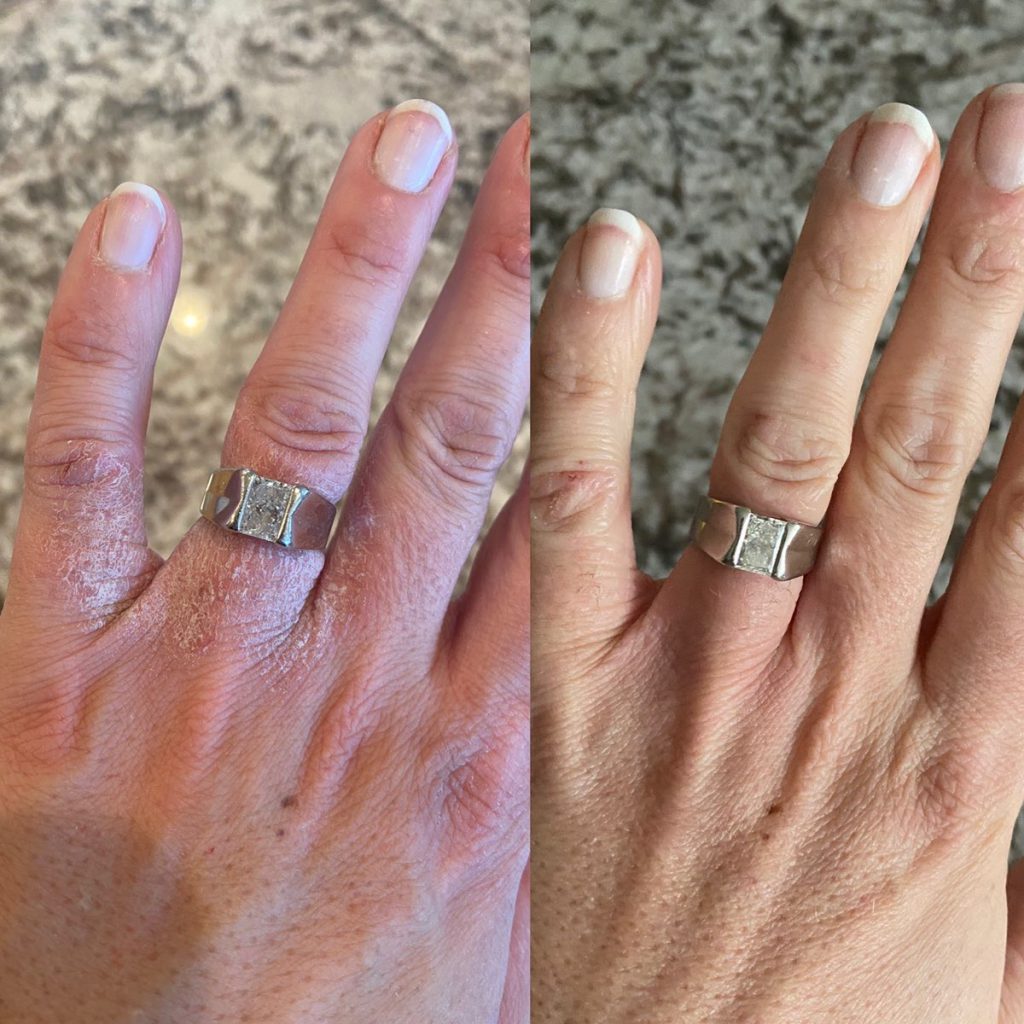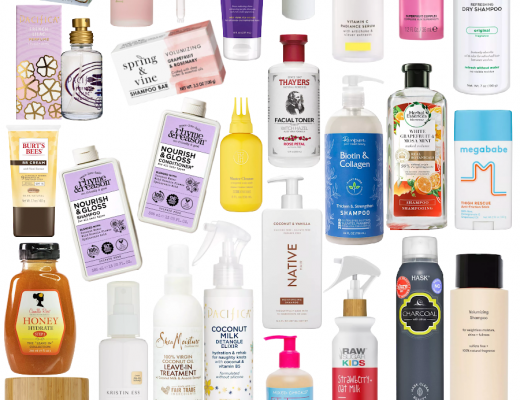Finding hand cream for dry hands that doesn’t hurt you or the earth can be a challenge. Whether you just want relief of a dry skin condition like eczema or you’re concerned about ingredient safety, I can help!

It works! These are the hands of a team member who helped me prep this info, read the to-do actions, did them, and got this result in THREE days! My top recommendations here.
Rebuilding the Moisture Barrier
Our skin acts as a barrier to the outside world – but it is not impenetrable! Protecting the moisture barrier (also called the lipid barrier or the acid mantle) is THE MOST IMPORTANT step in restoring skin health. When the moisture barrier is compromised it cannot protect you from potentially harmful bacteria.
The Science of Skin
Our skin’s epidermis is made up of 5 layers with stratum corneum, the moisture barrier, as the outermost layer. In and of itself it consists about 20 layers of specialized skin cells and keratin that are continuously renewing and exist to protect your insides. Eyelids are thinner, while layers such as your hands and heels are thicker.
Think of your skin like bricks and mortar: the bricks build themselves mostly with keratin, a protein also found in hair and nails. The mortar is made out of lipids that float into the space between the bricks as protection. Together it forms the skin’s protective barrier.
Optimum Hand Care
The stratum corneum is slightly acidic with a pH of ~ 4-5.5 (hence why it’s also called the acid mantle). This helps form an effective, waterproof barrier to the outside world, preventing epidermal water loss (drying out) and pathogens like bacteria and toxins in.
In order to improve the health of skin on hands, we need to think not of what we can see but of supporting the corneocyte structure. Continuing with the brick and mortar analogy, if the brick was spalling it would require some excavation to clean up around it (exfoliation) and then fresh mortar (lipids) to repair the cell structure inside out.
How long will it take to get relief? For non-injured skin tissue we expect it to regenerate within two weeks. (1)
Learn more in my in-depth article:
Ingredient Safety
While the two most important steps to seeing improvement are to exfoliate then nourish with a lipid, the ingredients you use have a significant impact. The wrong type of oils on the wrong person can be occlusive. For example, research shows that Vitamin E can improve certain skin disorders, such as dermatitis and eczema due to its antioxidant and anti-inflammatory bioactivities (2).
You find Vitamin E rich lipids in Avocado, Olive, Sweet Almond, and Sunflower Oils. All of those ingredients would be helpful for any dry skin condition, and especially nourishing for irritated hands. Most Botanical oils are going to be rich in ingredients that are antioxidants, naturally anti-inflammatory. They will also feel both lightweight and ultra-hydrating because of the lipids that penetrate deep for long lasting results.
Ingredients to avoid
Petroleum-Based
Mineral Oil derives from hydrocarbons obtained from petroleum. It is both harmful to the earth as well as potential to cause respiratory concerns, immunotoxicity issues, or allergic reactions.
Petrolatum, commonly known as petroleum jelly, results from crude-oil processing. It is a mixture of mineral oils and waxes, which form a semisolid, jelly-like substance. It is often contaminated with carcinogens (3). Risks and associated warnings issued by the Federal Food and Drug Administration, restrict petrolatum in food (what you put on your hands often ends up in your mouth).
Polyethylene glycol (PEGs) comprise petroleum-based compounds. Contamination of PEGs with the carcinogenic molecules ethylene oxide and 1,4-dioxane may occur as a by-product of production. Studies show they can carry unwanted substances across the skin barrier as well, especially if the skin barrier is compromised by a skin condition like atopic dermatitis, eczema or injured (5). Which, is interesting because dermatitis can be caused by PEG-22 and 45 from “skin-repairing creams”. (6)
And, the process of making any petroleum-based product creates toxic byproducts which can contaminate the raw materials.
Silicon-based
Cyclic Silicons are under restriction in Europe and Canada for Environmental Toxicity, as they take 50–500 years to break down completely. Look to avoid cyclotetrasiloxane (D4), cyclopentasiloxane (D5), cyclohexasiloxane (D6), and cyclomethicone), designated as persistent, bioaccumulative, and toxic. They’ve been show in rodent studies to result in reproductive harm as well as enlarged livers. (4)
Hand Cream for Aging Hands
Hands are on of the first thing that show signs of aging. In addition to botanical oils and Vitmain E, for anti-aging benefits look for ingredients that provide antioxidant or have other protective properties, such as:
Squalane is similar to your body’s own sebum, it comes from a lipid that naturally occurs in your skin (squalene). Squalane is the stabilized version that comes from plants and animals, used in skin care to increase hydration, and thanks to its anti-inflammatory properties, can help with acne and eczema. (7)
Vitamin C regulates the synthesis of the structural protein; it plays a role in boosting your skin’s collagen production to give you firmer, more plump skin and smooth out fine lines and wrinkles. Vitamin C has antioxidant properties that fight free radicals and oxidative damage caused by UV radiation (aging).
Hyaluronic Acid is naturally present in your skin. It binds to water to help retain moisture; however, the quantity reduces as we age. Sodium hyaluronate reduces signs of aging by providing moisture; it can attach and hold approximately 1,000x it’s weight! HA increases skin moisture and reduce the appearance of fine lines and wrinkles. HA can soothe redness and dermatitis and make skin appear firmer. (8) (9)
Learn more in my in-depth articles:
- Vitamin E: Skin Superfood
- 8 Reasons Petroleum Jelly has No Place in Your Lives
- Anti-aging: Top 3 Best and Worst Ingredients
Body Balm vs Butter & Hand Cream vs Hand Lotion
I’m still back at the study which showed the “skin-repairing creams” caused contact dermatitis. Those poor people probably kept putting on more lotion for short-term relief but then a build-up of more and more allergic reactions. I know I’ve had that happen with chapstick before I switched to safer. I literally became addicted to them, the more I used the more I needed. Be mindful: if you’re using a product that’s not giving relief over time, it may not be right for you.
The difference between a balm, butter, cream or lotion is oil percentage. A lotion will have a higher water content and be thinner. We formulate hand creams specifically for the thicker skin on that part of your body, but require a bit extra “work” to rub it in vs. your skin readily drinking up the water that would be in a lotion. Long-term results will be better with lipid-based formulas, as they help to repair the moisture barrier.

Top Recommendations
The products I have seen be most effective, as a combination of Vitamins and nutrients that serve as skin super foods are:
BODY & HANDS
- hands down (pun intended) this is the BEST product, the Swiss Army Knife of Skin but also you can apply a smidge to dry spots like you would a petrolum-based product with the benefit of lipids
- for everyday use, I carry this hand cream everywhere with me
- I use this oil on dry cuticles and cracked skin
- I prefer a body balm for my feet and elbows before bed, if you have particularly dry skin try this
- the most universal and beloved product is the super luxuriously rich body butter that smells like vacation
FACE
- this Cleansing Balm is THE bomb, it is the only thing that ever worked on my son’s dry skin
- for those fighting aging as well, this Cleansing Oil contains a Retinatural Complex proven effective
- while this formula is a water cream base, I talk about the benefits of ceramides to skin barrier here
Sources
- Growing New Organs
- Vitamin E in Atopic Dermatitis: From Preclinical to Clinical Studies
- EWG Research Shows 22 Percent of All Cosmetics May Be Contaminated With Cancer-Causing Impurity
- Swapping out silicone in our skin and hair products
- Altered Penetration of Polyethylene Glycols into Uninvolved Skin of Atopic Dermatitis Patients
- Allergic contact dermatitis caused by PEG-22 and PEG-45 dodecyl glycol copolymers in two skin-repairing creams
- What Is Squalane?
- Efficacy of a New Topical Nano-hyaluronic Acid in Humans
- Efficacy of cream-based novel formulations of hyaluronic acid of different molecular weights in anti-wrinkle treatment
Never want to miss an article, sale, or deal? Join my Healthy Inside & Out e-mail list for more info on non-toxic living and safer skincare!
Want more info on our Real Life? Healthy recipes, parenting tips, and general lifestyle stuff goes out in our Real Everything newsletter, join here.
You can keep up each week on Instagram and our newsletters.
Note: Stacy is not a medical professional. This article is for general educational purposes and NOT intended to diagnose, advise, or treat any physical or mental illness. We always recommend you consult a licensed service provider.






